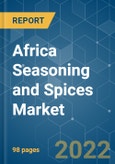The market for spices and seasonings witnessed a rapid uptick with the onset of the COVID-19 crisis. Some selected spices meant to provide immunity, such as turmeric, dried peppers, cinnamon, dried garlic, ginger, and echinacea, received tremendous response in the market studied. Spices with medicinal ingredients sales in Zambia have more than doubled during the COVID-19 period, according to Lusaka-based dealers, and vendors are constantly running out of stock.
The African market is booming due to the tourism it attracts, especially in South Africa. The food market is growing and so is the spices and seasoning market. The entire market is gaining popularity due to tourism. The demand from consumers for high-quality healthy food ingredients, along with the increased preference for trying out new flavors in the foodservice sector and processed food products, is supporting the overall spices and seasonings market’s growth, leading to an upward trend, hence driving the market growth during the forecast period.
The growing demand for innovative spices and seasonings is predicted to be an opportunistic factor. Moreover, increasing government initiatives for promoting organic food and organic farming to maintain environmental health is further influencing the demand growth for organic spices.
Key Market Trends
Growing Popularity for Ethnic food
With ethnic foods becoming increasingly accessible and mainstream, consumers are developing an appetite for new and exciting spices and seasonings. Reasons for this increase in ethnic cuisine include the growing multicultural population and the fact that people are traveling more and more to exotic destinations. As a result, the demand for spices, herbs, and seasonings used in exotic cuisine is also growing. This growing demand for ethnic food in Africa has led to significant growth in Africa's imports of spices, herbs, and seasonings from developing countries in the region. One of the primary aspects driving the spices and seasoning market in Africa is customers' willingness to try different flavors and ethnic cuisines. As a result, there has been an increase in demand for diverse spices and seasonings.
Meat, Poultry, and Seafood Remains the Largest Market Segment
Dry rubs and wet rubs are the spice blends commonly known. They are spice blends mixed with water or oil and are a great way to improve the flavor and preservation properties of meat. These blends are added to meat, fish, and poultry as a marinade. Black pepper is common in rubs, and so are ground hot peppers such as cayenne or chipotle. Ginger, horseradish, and mustard powder are also included in this category. Spices and seasonings are also used in the preparation of sausages. Pepper, red pepper, paprika, garlic, rosemary, thyme, cloves, ginger, and nutmeg are the most commonly used spices in sausages. Cinnamon and cardamon are the most often used spices to flavor numerous meat meals. To enhance the tastes and flavor of meat, fish, and other dishes offered in restaurants, various spices are used to prepare a range of sausages and dips. Specialist spice-mixing companies increasingly assist the meat trade by producing ready-to-use spice mixtures for meat, as well as for sausage factories.
Competitive Landscape
The seasoning and spices market in Africa is fragmented, with leading companies that are driving the growth. Some of the major players in the Africa seasoning and spices market are McCormick & Company Inc, Kerry Group, and Givaudan, among others. Moreover, companies are teaming up with industry partners and key stakeholders through the sustainable spices initiative (SSI) to find more collaborative ways to accelerate and scale sustainability within the category.
Additional Benefits:
- The market estimate (ME) sheet in Excel format
- 3 months of analyst support
This product will be delivered within 2 business days.
Table of Contents
Companies Mentioned (Partial List)
A selection of companies mentioned in this report includes, but is not limited to:
- Spice Importers and Millers CC
- Freddy Hirsch Group
- McCormick & Company Inc
- Givaudan
- Kerry Group
- Exim International (Pty) Ltd
- Organic Spices Inc.
- Spice Chain Corporation
- Natpro Spicenet (Pty) Ltd
- Deli-Spices (Pty) Ltd








